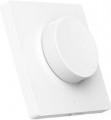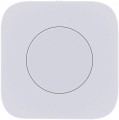Mount
—
In the mounting box. The design of the switch involves hidden (embedded, internal) installation in the wall. After installation, only the button framed by the front decorative panel remains available to the user, and the electrical contact group itself is placed in the mounting box (glass), which, in turn, is fixed in the wall technological connector, from where hidden wiring is output. Recessed switches are good because only the framed button protrudes from the wall. Among the minuses can be noted the complexity of the connection. Additionally, the location of the mounting boxes for switches must be planned at the stage of laying hidden wiring.
—
Outdoor. The switch for outdoor (surface) installation is represented by a sealed housing with a push button, which protrudes significantly above the wall level. The electrical fittings themselves are installed on a mounting plate, which in turn is fixed directly to the wall surface. Outdoor switches are designed to be connected to outdoor wiring. Solutions of this type are especially relevant in those cases when it is necessary to equip a wall partition with a switch, on which it is not possible to embed a mounting box. An important advantage of outdoor switches is the ease of connection and installation. The body of the overhead electrical accessories can be easily disassembled, which allows you to quickly and easily connect the wiring, and to fix th
...e switch, simply screw the mounting plate to the wall / partition.Switches
—
Keys. The key is an elongated pressure surface with two working positions. When the upper end of the key is pressed, the circuit closes and the electric current consumer is turned on, and when the lower end is pressed, the electrical circuit opens, instantly turning off the current consumer. Pushbutton switches are used to control current consumers that require a fixed contact/shutdown (lighting, ventilation, etc.). The key mechanism is distinguished by its simple design and high reliability.
—
Buttons. Button — a point pressure surface, when exposed to which the electrical circuit closes, including the current consumer. The return of the button is most often implemented due to the spring mechanism — by removing the finger from such a button, the contact automatically opens, turning off the power. Pushbutton switches are used to control bells, as well as to turn on the drive on roller shutters / blinds, gates, etc. That is, the button is used where it is necessary to turn on the current consumer for a short time, without fixing the switched on position. Additionally, the switch button can be implemented by a reciprocating mechanism with fixation in several positions: the first pressing of the button statically closes the electrical circuit, and the second pressing is necessary to open the circuit.
—
Sensor. The sensor is an electromagnetic sensor tha
...t responds to touch with a fingertip. It is enough to lightly press the working surface of the touch sensor, as the electrical circuit closes / opens. The main advantage of the sensor is the absence of rubbing pairs that are subject to mechanical wear. Also, touch-sensitive electrical accessories do not emit a click characteristic of keys and buttons. Usually, touch switches are more expensive than mechanical counterparts using buttons / keys.
— Rotary dimmer. Rotary dimmer — a regulator with a switch rotating in a circle. The dimmer allows you to smoothly adjust the voltage supplied to the current consumer. Most often used for dimming in special dimmable LED lamps, but also applicable to many other current consumers, from climate control programmers to electric motors on blinds, roller shutters and gates. When choosing a rotary dimmer, you should pay attention to its compatibility with the consumer of electric current.
— Button dimmer. Pushbutton dimmer — a regulator consisting of a two-position switch. When you press the top edge of the dimmer, the voltage supplied to the consumer increases, and when you press the bottom edge, the voltage decreases. Usually, a button dimmer is used to control the brightness of special dimmable LED bulbs, but there are button dimmers for other current consumers, from heaters to electric shutters. Most often, a push-button dimmer is additionally equipped with a separate switch key — the dimmer becomes active after the electric current consumer is turned on.
— A toggle switch is a special switch represented by a dielectric lever. The toggle switch is used to turn on, open and switch power in various electrical networks. There are toggle switches of mechanical, electronic and electromagnetic types.Backlight
The backlight allows you to find the exact location of the switch in the dark. Often, the backlight is combined with an indicator of the presence of a network.
Wire connection
—
Screw. The wiring is fixed to the electrocontact group using screws with a Phillips head or a flat screwdriver. The threaded surface of the screw acts on the pressure plate, which clamps the bare part of the wire. Screw connection of wires is valued for the ability to control the clamping force of the wiring. The main disadvantage of this solution is the spontaneous loosening of the tightening, which occurs due to frequent changes in temperature in the threaded surface. For this reason, leading manufacturers of electrical accessories are beginning to slowly move away from the screw method of connecting wiring.
— Clamp. The wiring is fixed with a spring clip. To insert the wire into the terminal block, it is necessary to lift the lever of the spring clip. The wire is fixed under the force of a stretched spring. The main advantage of a self-clamping connection is the ease of fixing the wires. There is no need to screw in / unscrew the screws, which saves time and effort. Additionally, the spring clamp is not subject to weakening of the fixation due to the high dynamics of the temperature regime. Among the shortcomings, one can single out the inability to control the clamping force of the wiring. Electrical fittings with self-clamping terminals are more expensive than analogs with screw clamps.

